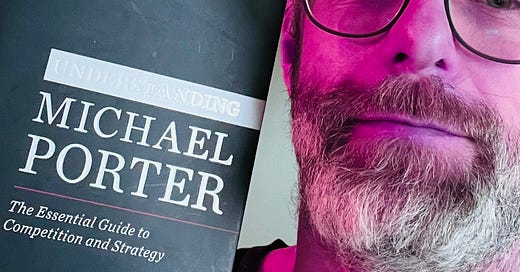About Strategy: “Understanding Michael Porter” by Joan Magretta, Day 2.
I am reading the book “Understanding Michael Porter” by Joan Magretta. Over the next weeks I will post my personal highlights.
I am reading the book “Understanding Michael Porter” by Joan Magretta. Porter is all about strategy. He is the most cited scholar in economics and business and his ideas are widely used in business and governmental affairs. Howard Wenger, President of the US solar company Nextracker, recommended Porter to me during a podcast recording for The Solar Journey. I got quickly intrigued by the way Porter understands strategy. He wants to give a framework that is so general but also specific and applicable at the same time that it is more science than art. That’s what got me, being a scientist by training myself.
DAY 2
Before she dives into details, Joan gives an introduction or roadmap on what's to come. As often in good books, the introduction is already so heavily loaded that you feel the intro itself is already the actual book. Check-out the management book “Scaling-up” by Verne Harnish, similar effect.
The book is split into two parts. Part 1 is on competition, part 2 on strategy.
Part 1, competition:
Chapter 1 of part 1 is about the mind-set for competition. “Competition is NOT about being the best. This would be a race to the bottom, zero profit. It’s about being unique. Only this allows a company to achieve sustained, superior performance.”
Chapter 2 is about the five forces, Porter’s “science of strategy”. Strategy is about capturing the value which is created by an industry. The five forces help you to gain insight about an industry and your own performance.
Chapter 3 is about competitive advantage, the value chain and P+L. Porter uses a very specific definition of the often (mis-) used term competitive advantage. His definition: the competitive advantage allows you to follow the precise link between the value you create, how you create it (your value chain), and how you perform (P+L). Competitive advantage is NOT the weapon you use to destroy your competitor. It’s about creating value and how your value chain is DIFFERENT and your P+L BETTER than the industry average.
Part 2, strategy:
Chapter 4 is about the core, creating value. A strategy must be based on a unique value proposition (first test of a strategy). But the strategy is only good if the best set of ACTIVITIES to deliver the USP are different from the activities of rivals (test 2). Competitive advantage lies in the activities, in the value chain! This is something I personally haven’t seen this way or/and haven’t fully understood. Hopefully, the book will do its magic on me. Until now, I thought it’s about the USP only.
Chapter 5 is about making trade-offs and accepting limits, maybe the hardest part (test 3). Joan’s example is that you might need to say no to some customers so that you can better service others. Trade-offs arise when choices are incompatible. These choices, in turn, make you more resilient against competition because your choices might be in conflict with the competitors strategy. I assume that point is the root for the statement right in the beginning: “The essence of strategy is choosing what NOT to do.”
Chapter 6 is about fit and amplification of activities (test 4). As mentioned before, a strategy is a set of activities different from the ones from rivals. These activities should fit and amplify each other, there should be synergies so that the effect of the activities become even stronger or cost less effort. A complex set of interdependent activities is hard to copy, so that you become more resilient. This is in contrast to the often cited focus on a single core competence. I never liked that anyhow. As if Jeff Bezos core competence is selling books.
Chapter 7 is about continuity, the enabler. Don’t change too little, don’t change too fast. Take time to understand the value you create, to adopt, to make trade-offs.
The epilogue gives a set of takeaways of how Porter’s ideas can be applied in practice.
There is also an interview of Joan with Porter.



